IEI History
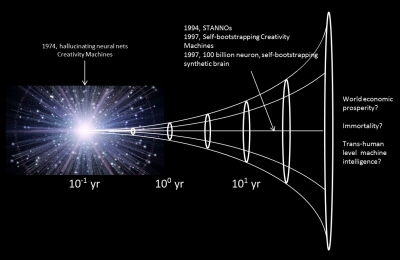 Summer, 1976. Early Experimentation. While studying theoretical solid state physics in graduate school, Thaler begins experimentation with lattice models of both ferromagnetic and ferroelectric materials using Ising models and crude Boltzmann Machines. He soon finds great fascination in raising the computational temperature of such lattices beyond their Curie points and watching the dissipation of memories frozen into them. Especially interesting is the observation that these 'dissolving' memories often lead to meaningful ideas!
Summer, 1976. Early Experimentation. While studying theoretical solid state physics in graduate school, Thaler begins experimentation with lattice models of both ferromagnetic and ferroelectric materials using Ising models and crude Boltzmann Machines. He soon finds great fascination in raising the computational temperature of such lattices beyond their Curie points and watching the dissipation of memories frozen into them. Especially interesting is the observation that these 'dissolving' memories often lead to meaningful ideas!
December 24, 1988. A Grizzly Experiment. Thaler teaches a large multilayer perceptron several popular Christmas carols and then proceeds to destroy it through simulated neuron death. During such near-death simulations, with all meaningful inputs denied the net, the perceptron's outputs are dominated not by nonsense, but meaningful new lyrics such as "in the end all men go to good earth in an eternal silent night."
May, 1993. Scientific American Gets It. Philip Yam of Scientific American first writes about Thaler's near-death simulations with artificial neural networks in an article entitled "Daisy, Daisy...Do computers have near-death experiences? (see Yam, P. (1993), Scientific American, 268(5), 32-33). Interestingly enough, Yam thought that these near-death experiments were similar to those simultaneously carried out by George Hinton and David Plaut at Carnegie-Melon involving the lesioning of small neural networks to simulate dyslectic symptoms. The Scientific American editor suddenly realized the big difference though when he realized that Thaler's nets had no applied inputs. The networks were hallucinating (or alternately, ideating) things that simply weren't there. In addition to offering a reductionist model of near-death experience, the simulation hinted at the generative aspects of internally damaged neural nets, simulated or biological.
October 30, 1994. Princeton Invited Talk. At the invitation of the Princeton Chemistry Department, our founder delivered a talk on the Creativity Machine, thereafter brainstorming with faculty about how the system could be applied in chemical kinetics research.
October 31, 1994. The Neural Juice Party. On Halloween, various IT personalities from the St. Louis community gather to concoct mixed drinks as attendees sample and rate them. A Creativity Machine absorbs these opinions and then recommends both optimal and minimal drinks at midnight! There was general consensus that the former was pretty good, and the latter detestable. In essence this was the first exercise of creative AI in crafting new foods/beverages.
 January, 1995. First Academic Acceptance. The journal Neural Networks publishes an article by Thaler entitled "'Virtual Input' Phenomena within the Death of a Simple Pattern Associator." In this article, he describes an experiment in which a simple multilayer perceptron, denied meaningful inputs and synaptically perturbed produces a stream of patterns that consist primarily of memories stored within that net. The article also discusses the appearance of output patterns that do not belong to the net's repertoire of memories (i.e., confabulations), thus foreshadowing the Creativity Machine. Note the animated figure to right captures a demonstration to government in 1994, showing how a trained network may be 'looking' at one thing and activating into such confabulations. In other words, a simple imagitron had been formed, the generative portion of a Creativity Machine. (look familiar?)
January, 1995. First Academic Acceptance. The journal Neural Networks publishes an article by Thaler entitled "'Virtual Input' Phenomena within the Death of a Simple Pattern Associator." In this article, he describes an experiment in which a simple multilayer perceptron, denied meaningful inputs and synaptically perturbed produces a stream of patterns that consist primarily of memories stored within that net. The article also discusses the appearance of output patterns that do not belong to the net's repertoire of memories (i.e., confabulations), thus foreshadowing the Creativity Machine. Note the animated figure to right captures a demonstration to government in 1994, showing how a trained network may be 'looking' at one thing and activating into such confabulations. In other words, a simple imagitron had been formed, the generative portion of a Creativity Machine. (look familiar?)
October, 1995. Most Prolific Musician of All Time. A Creativity Machine, trained on top-ten melodies over the preceding 30 years proceeds to invent 11,000 new musical hooks that are promptly copyrighted. Interestingly enough human musical artists disdain the copyright, protesting that "only human minds can conceive music!" Thaler holds back on a million song database generated via Creativity Machine in view of the spirited protests from human artists. ...On the flip side, computational musicians don't get it either, feeling that they can do the same thing, spending months or years concocting new works of art via computer. What they don't realize was that only a few hours had been spent by Thaler in translating sheet music to a representation more conducive to neural nets. Beyond that, Creativity Machine function was spontaneous and voluminous. (See Noorderlicht documentary where apart from the program's introductory and closing musical theme, the background score is that of a Creativity Machine.)
March, 1996. The Creativity Machine Trains Itself The Creativity Machine learns to train itself without recourse to traditional training algorithms (i.e., backpropagation) written by human programmers. The result of this experiment is the "Self-Training Artificial Neural Network Object" or STANNO. More importantly, STANNOs could incorporate whole neural networks as neurons, allowing either (1) autonomous device prototyping as components, represented as neural nets, interconnected themselves to perform some overall system function or (2) analogies, again represented by neural modules, spontaneously connected themselves to devise theories about their environment. Most importantly, the STANNO paradigm now enabled Creativity Machines to autonomously learn from their environments as well as from their own mistakes!
May, 1996. Creative Computers Documentary. A film crew from the Dutch science documentary program Noorderlicht camps out at IEI headquarters for three days to film the program "Creative Computers." The television program attracts a large audience in the U.K. and western Europe, but not the U.S. Here is their brief synopsis of the documentary: "The American Steve Thaler works with neural networks. He makes them dream and die. Through this process the networks develop elementary creativity. Thaler uses this phenomenon to compose music, design cars and finding new superconducting materials."
August 8-9, 1996. Adaptive Parallel Computing Conference. Thaler, assisted by his first summer intern, Dan Redmond, presented three ground breaking papers on Creativity Machines, totally self-training artificial neural networks, and DataBotsTM at the Adaptive Distributed Parallel Computing (ADPC) Symposium in Dayton, Ohio, August 8-9, 1996.
September 15, 1996. World Congress on Neural Networks. Thaler presented three papers at the World Congress on Neural Networks '96 in San Diego. Featured among these talks was a paper entitled, "Is Neuronal Chaos the Source of Stream of Consciousness?" This research further substantiates the Creativity Machine Paradigm as the neurological mechanism dominating human creativity, discovery and invention.
July 18, 1996. The First Interactive Neural Network on the Internet. On this date, IEI placed the first interactive neural network on its corporate web site to calculate physical and chemical properties of chemical compounds. Users provided elements and stoichiometry triggering the neural network to generate an active server page enumerating compound characteristics.
January, 1997. New Scientist Magazine Responds. New Scientist Cover Story "Creative Noise" is about Thaler's Creativity Machine Paradigm, wherein one network stimulated to dream new concepts via mild synaptic perturbations is supervised by a second neural network that mines for the very best of these emerging ideas. The author, Bob Holmes does a good job on the technical reporting in spite of painting Thaler as a horned heretic. Unfortunately, the article ends on a low note as the inevitable 'AI guru' likens the Creativity Machine to a perpetual motion machine. ...But guys, the Creativity Machine does not manufacture energy, it's an entropy-driven machine and any scientist having the slightest familiarity with thermodynamics knows that entropy is plentiful and always increasing! (see Holmes, R. (1996). The Creativity Machine, New Scientist, 149(2013), 20 Jan., 1996, 22-26).
April 1, 1997. First On-line Article on Autonomous Materials Discovery via Creativity Machine. The April issue of JOM-e featured results from the first in a series of autonomous materials discovery machines in an article entitled "Autonomous Ultrahard Materials Discovery via Spreadsheet-Implemented Neural Network Cascades."
July 15, 1997. The Creativity Machine Debuts in Australia. Thaler presented a paper entitled "Network-Based 'Creativity Machines' for Materials Discovery" at the Australia-Pacific Forum on Intelligent Processing and Manufacturing of Materials, Gold Coast, Brisbane Australia.
September 23, 1997. National Academy of Science Presentation. Thaler addressed the National Materials Advisory Board at the National Academy of Science, in Wood's Hole, MA, with a talk entitled "Autonomous Materials Discovery by Artificial Neural Networks." While well received, most present did not accept the possibility of science autonomously performed by machines!
August 19, 1997. The Creativity Machine Patent Issues the Same Day that SkyNet Becomes Conscious. Thaler is awarded his first neural network patent, US 5, 659,666, "Device for the Autonomous Generation of Useful Information." Onlookers muse that this is the date that SkyNet, the fictional AI-based defense satellite system of the Terminator series, becomes conscious and destroys the world. Revelation fans suspiciously eye the patent number. Likewise that day, MSN News reports the patent as potentially the most important invention in history, one that can invent all subsequent science, technology, and art.
August, 1997. The Future of All Technology is Incorporated. Imagination Engines, Inc. (IEI) is incorporated as a Missouri S-Corporation after having done business under the name of Dendrite Neurocomputing from 1995 until that time. IEI's first contract is to design a new toothbrush for a major personal hygiene company. IEI successfully designs that toothbrush, soon featured on U.S. television networks.
September 15, 1997. Revelations on Computational Creativity in Dublin. Thaler presents a paper entitled "A Quantitative Model of Seminal Cognition: The Creativity Machine Paradigm" at the Mind II Conference in Dublin, Ireland. Amidst myriad discussions of rule and genetic algorithm based computational creativity, Thaler introduces the totally novel concept of completely autonomous machine creativity using purely neural network based systems in which one synaptically perturbed network that has been exposed to patterns from some conceptual space, produces false memories or confabulations generalized from that space, while another neural network selects concepts from this stream having potential value or utility. The resulting combination of generative and watching neural net is coined the "Creativity Machine Paradigm." Thaler then proves the equivalence between the Creativity Machine and human cognition (creative or not) through empirical studies and the Fractal Theory of Brownian Motion.
 Fall, 1997. The International Expirer. A Creativity Machine exposed to several hundred tabloid headlines autonomously creates new potential tabloid headlines. This neural architecture drove an IEI web site known as the "International Expirer" for two years providing myriad new potential tabloid headlines and chuckles for millions.
Fall, 1997. The International Expirer. A Creativity Machine exposed to several hundred tabloid headlines autonomously creates new potential tabloid headlines. This neural architecture drove an IEI web site known as the "International Expirer" for two years providing myriad new potential tabloid headlines and chuckles for millions.
February 25, 1998. Encyclopedia of Myriad Could-Be Materials. Having been awarded a Phase I SBIR entitled "Integrated Substrate and Thin-film Design Methods" by the Air Force Research Laboratory, Wright-Patterson Air Force Base, Ohio, IEI embarks upon the construction of a materials discovery Creativity Machine. After nine months of data gathering this Creativity Machine generated an encyclopedia of approximately a half-million new potential chemical compounds and systems and corresponding, technologically significant chemical and physical properties. Within this compilation are thousands of new materials discoveries ranging from new potential high temperature superconductors to trans-diamond ultrahard materials.
July 30, 1998. The End of Science. Thaler presented a talk entitled "The Beginning of the End of Science: The Creativity Machine Paradigm," at Wright State University, as part of the The Materials and Manufacturing Technology Series of the Air Force Research Laboratory.
December 1, 1998. Neural Nets without Explicit Training Algorithms. The first Self-Training Neural Network Object (STANNO) patent issues (U.S. 5,845,271, "Non-Algorithmically implemented artificial neural networks and components thereof").
April 20, 1999. Delivering What AI Originally Promised. Thaler, presented an invited lecture on IEI's bleeding edge neural network technologies to NASA at its Langley Research Center. The talk was appropriately entitled "Delivering What AI Originally Promised: The Creativity Machine Paradigm."
August 8, 1999. Thinking Neural Nets Join General Electric Forging Initiative. IEI subcontracts with Ladish Co., Inc. and General Electric to carry out neural network activities under the GE Forging Supplier Initiative.
August 13, 1999. The Creativity Machine Designs Its Own Weapons. IEI sold Eglin Air Force Base a site license for a Warhead Simulation Creativity Machine, under its Revolutionary Ordnance and Guidance Technologies Initiative. See WSTIAC 3(1), 2001, The Warhead Design Creativity Machine
October 9, 1999. The Creativity Machine Gets a Boost from Reconfigurable Computing. Thaler met with Kent Gilson and Al Dimora of Starbridge Systems, producers of the HAL-series hypercomputers. During this meeting, it was generally agreed that Starbridge computational horsepower and IEI's powerful AI paradigms should be combined within a collective effort to equal or surpass human intelligence! ...Stay tuned.
October 21, 1999. IEI Technology Helps to Provide Equal Access to Justice. Thaler met with the Legal Aid Society of Orange County, Santa Ana, California, to form a significant alliance in the application of IEI's suite of intellectual property to various legal issues. This overall effort was approached in the spirit of providing equal access to justice across all demographic sectors.
September 13, 2000.Advanced Neural Technology on the Internet. Thaler presents the invited talk, "Understanding DataBots and Neural Networks on the Internet" at BOT2000. The talk is well received by this important conference, hosted by the prominent Internet personality, Marcus Zillman.
September 14, 2000. IEI Neural Networks in Network Intrusion Detection. Together with long time friend and network security specialist, Rusty Miller, Thaler presents the talk "Twisted Technology: The Dark Side of Enabling Technology." In the course of this presentation, he reveals the first experiments in which adaptive IEI neural filters autonomously detect network intrusions and anomalies, while IEI Creativity Machines devise Machiavellian schemes to neutralize such mischief. This talk features the first reduction to practice of artificial neural networks, training and filtering in real time, off of firewall as well as network traffic, to determine network intrusions.
January 25, 2001. IEI's Vision of a World Brain is debuted in San Fransisco. Thaler presented the talk "Toward a World Brain" at BOT2001, San Francisco, CA in which he first publically discloses his plan for converting the TCP/IP nodes of the Internet into a free-thinking entity that may learn and create on unprecedented levels.
June 19, 2001. IEI's Vision of a World Brain is Debuted in Boston. Thaler repeated his groundbreaking talk on the World Brain Project, now on the East coast, under the new title of "Enabling a World Brain" at BOT2001 East, Boston, MA.
 August 2001. Pareidolia and Art. In preparation for Infowarcon (just below) and multi-billion neuron neural net is shown hundreds of gray-scale faces, thereafter being shown an image of that famous face on mars. The system ten carries out faulty pattern completion to produce the image of an imfamous dictator (see copyrighted image), with spock-like ears, and wearing a spacesuit. Of course, the technique was perfected even more at IEI, long before the big search engine company did and here are some of the results, free of the 'psychedelic' artifacts. Here, for instance such erroneous pattern completion is being seeded by the demise of connections within an even larger artificial neural system.
August 2001. Pareidolia and Art. In preparation for Infowarcon (just below) and multi-billion neuron neural net is shown hundreds of gray-scale faces, thereafter being shown an image of that famous face on mars. The system ten carries out faulty pattern completion to produce the image of an imfamous dictator (see copyrighted image), with spock-like ears, and wearing a spacesuit. Of course, the technique was perfected even more at IEI, long before the big search engine company did and here are some of the results, free of the 'psychedelic' artifacts. Here, for instance such erroneous pattern completion is being seeded by the demise of connections within an even larger artificial neural system.
September 6, 2001. More Twisted IEI Technology at Infowarcon. Together with long time friend and network security specialist, Rusty Miller, Thaler again presented the talk "Twisted Technology: The Dark Side of Enabling Technology." In the course of this presentation, he reiterates the first experiments in which adaptive IEI neural filters autonomously detect network intrusions and anomalies, while IEI Creativity Machines devise Machiavellian schemes to neutralize such mischief. This talk again features the first reduction to practice of artificial neural networks, training and filtering in real time, off of firewall as well as network traffic, to determine network intrusions.
October 19, 2001. The True World Brain. Thaler presented an invited talk at the World Knowledge Forum, in Seoul Korea, "TCPIP-Why Can't the Internet be a True World Brain?" The talk sharply contrasted with the forum's overall attitude that a library, distributed across the Internet, constituted a brain. In contrast, IEI's founder presented the theory, philosophy, and most importantly, the patented IEI technology required to produce a free-thinking and creative entity among the many TCP/IP nodes of the Internet.
December, 2002. A Creativity Machine Generates One Million New Potential English Words. In an effort to demonstrate the superiority of Creativity Machine Paradigm over genetic algorithms, a Self-Training Artificial Neural Network Object is pointed at the World Wide Web where it begins to autonomously read web content forming a 'Zen' model of the typical English word. Run in the Creativity Machine mode, this STANNO then generates a soon to be published compendium of over 1.5 million new, potential, functional English words plentiful in novel product, service, and corporate names.
Fall, 2002. Human Level Vision on PCs!. Thaler extends STANNO technology to new heights with the development of a Giga-STANNO, capable of instantiating itself into multi-million input-output multilayered neural networks and processing input patterns on scales characteristic of human vision.
December, 2002. IEI Vision Applications Displace 'If-Then-Else' Programmers. Thaler connects multi-million input-output multilayered neural networks to several popular cameras to produce highly advanced machine vision systems. In addition to performing anomaly detection in highly dynamic environments, they may be trained in a matter of seconds to classify complex objects. A ground swell develops in Detroit as large companies abandon "if-then-else" programming efforts in machine vision, in favor of the rapid, efficient, and autonomous IEI neural paradigms.
March 2003. IEI's First Limited Liability Partnership, Neurocomputing for Dollars. IEI spins off its first company, Synaptrix Financial Prediction LLC, building massively parallel neural network systems training off of live feeds from the NASDAQ exchange and making minute by minute predictions of stock price motion. This new LLC now begins the pattern of IEI's strategic business model, to build myriad enterprises based upon its inevitably ubiquitous science and technology.
April 1, 2003. The Neural Undresser. Committed IEI researchers reduce to practice the "neural-undresser," a million input-output multilayer STANNO that has cumulatively learned to process the image of a fully clothed individual and display at its outputs how that subject would appear in the buff! Implemented on a 2 GHz P-4 processor, the network could perform both training and feedforward function on 50 millisecond time scales, qualifying it to perform as a real time signal processor for live television. Super V-Chips based on IEI technology could spice up normal TV broadcasts or instantaneously cover 'naughty-bits' for the more noble-minded.
April 29, 2003. Robots Get Creative. IEI was notified that it had been awarded a Phase I SBIR from the Munitions Directorate of the Air Force Research Laboratory. In this nine month effort, entitled "Creative Robots to Defeat Deeply Buried Underground Targets," IEI will determine the feasibility of using its extensive patent suite to build an integrated development environment for the synthesis, testing, and implementation of innovative robotic swarms.
May, 2003. IEI's Second LLC Exploits IEI Vision for Manufacturing Quality Control. IEI spins off its second company, Synaptrix Parts Inspection LLC to exploit IEI's advanced machine vision capabilities to perform quality control in the automotive industry.
June 6, 2003. IEI Receives a U.S. Copyright for 1 Million New Potential English Words. In addition to producing a wealth of new corporate, product, service, and domain names, this project serves to illustrate the tremendous advantage of Creativity Machine Paradigm over Genetic Algorithms (the only perceivable competition in computational creativity): In an entirely autonomous process, the Creativity Machine surfed the World Wide Web and absorbed the 'Zen' of the typical English word. Subsequently set loose to create, this neural system spontaneously generated over a million new, pronounceable words. In contrast, the genetic algorithms required to produce similar linguistic results require enormous amounts of human involvement and tend to produce words that do not reflect the myriad, subtle constraints present in the English language. (See PR Web, 5/23/2002)
June 23, 2003. Source of Inspiration Represents IEI in Japan. IEI and Source of Inspiration, Ltd. officially formed a business alliance in order to develop successful licensing and joint venturing businesses with Japanese companies by leveraging and combining the Imagination Engines intellectual property portfolio and the business experience and contacts of Source of Inspiration Ltd. in Japan.
October 3, 2003. Virtual Reality Robots Become Creative and Self-Determining. On this date, a self-forming, synthetic central nervous system based upon IEI's neural network patent suite demonstrated the ability to master the simulated physics of its environment and to 'invent' the necessary leg/body motion to walk, run, and devise clever maneuvers to navigate complex structures built in virtual reality simulators. Using the test bed of a virtual hexapod crawler inspired by insect studies, this synthetic CNS devised the necessary body dynamics to achieve generalized locomotive goals (i.e., crawl through doorways or in a circle) dictated by a virtual sensor suite (i.e., virtual sonar) and the 'will' of its contemplative neural networks. Additional neural structures within the roach's synthetic central nervous system autonomously identified and classified novel objects placed within the VRML simulation (see IEI Virtual Robotics).
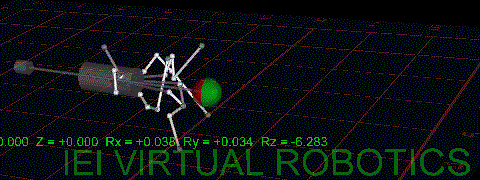
Roachbot learns to stand and walk.

Roachbot running forward and backward using self-devised strategies.
October 15, 2003. IEI virtual reality robot learns to stand and walk. IEI VR robot learns to run forward and backward. IEI VR robot swarm cooperate in mapping a facility. (above) IEI virtual reality robot with 36 degree-of-freedom leg system (i.e., roach-bot), learns to stand and then walk. - Note robot first learns to stand upright and then experiments with leg gaits to achieve forward motion. (above) IEI virtual reality roach-bot, learns to run forward and backward. - As it trains itself to walk, forward and backward gaits become much more efficient. (below) Swarm of IEI VR roach-bots coordinate their sonar sensors and leg system to cooperatively map out a randomly generated "facility." - The roaches, communicating via TCP/IP, minmize their overlap in mapping the facility, combining their sonar returns to generate its floor plan.
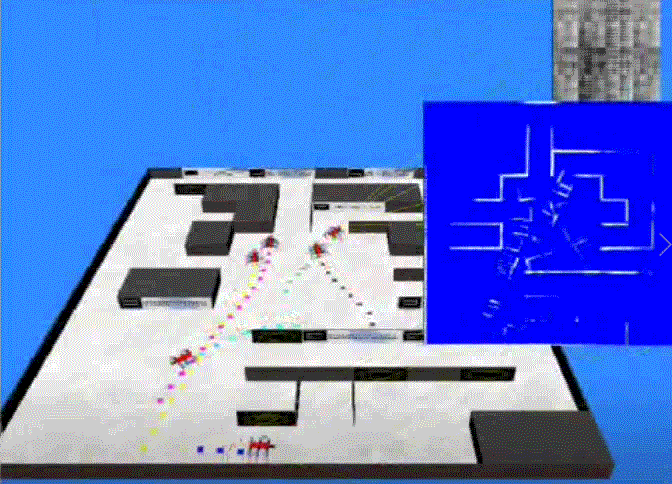
Roachbot swarm mapping a randomly generated 'facility'.
January 25, 2004. The Machine That Invents. For two days in a row, the Creativity Machine Paradigm dominates the front page of Pulitzer's flagship publication, the St. Louis Post Dispatch. The article is brilliantly conceived and executed by Tina Hesman, Ph.D., of the Post. To see for yourself, here is the pdf version of the article, The Machine That Invents.
March 26, 2004. Phase II SBIR Award for Creative Robots. The Air Force Research Laboratory has awarded IEI a Phase II SBIR entitled "Creative Robots to Defeat Deeply Buried Targets." This will be a $750K contract to be conducted over a 24 month period.
April 23, 2004. Robots Devise Their Own Complex Strategies. With absolutely no human mentoring, an 18 degree of freedom hexapod robot, developed its own behavioral repertoire with absolutely no human inputs. In other words, the robot developed its own strategies for forward, backward, right turn, left turn, right shuffle, and left shuffle movement. The individual neural networks then knitted themselves autonomously into a larger neural network that allowed the same robot, equipped with a sonar sensor, to autonomously navigate through representative buildings and complexes so as to thoroughly map them. ...This is the first time in history that such a thing has been done. Any other accounts of autonomous learning and creativity, must inevitably be based upon the patented Creativity Machine Paradigm.
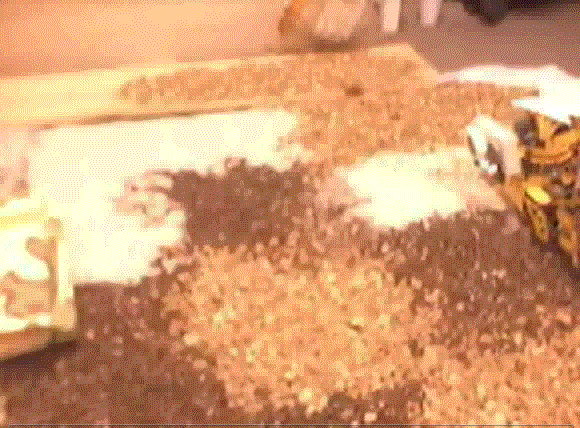
Roachbot contemplates path of least resistance to its target.
April, 2004. IEI Terrain-Seeking Hexapod Finds Its Target and Contemplates Path of Least Resistance to It. The hexapod robot uses machine vision to locate its intended target, a toy missile launcher. A Creativity Machine devises a path of least resistance through the terrain, as well as appropriate leg motions, to move the robot toward its target. (Note - The robot has little traction in the light brown gravel just in front of it, so it contemplates the terrain and finally decides on a path around the material.)
April 25, 2004. Symposium on Intentional Dynamics. IEI President & CEO, Stephen Thaler presented a talk entitled "Creative Robots based Upon U.S. Patent 5,659,666, Device for the Autonomous Generation of Useful Information" at the Symposium on Intentional Dynamics at the University of Memphis.
May 4, 2004.IEI Address to American Concrete Institute. In an invited address, IEI President & CEO, Stephen Thaler presented the talk "The Most Important Technology of Them All, Applications to the Concrete Industry," to the Strategic Development Council of the American Concrete Institute meeting at Amelia Island Plantation, FLA.
May 6, 2004. TSA Contract Awarded to IEI and Montana Tech. TSA has awarded a joint contract to Montana Tech and IEI to develop new network centric systems for airport security. As part of this $800K contract, IEI will be testing its advanced vision systems at the Butte, Montana airport.
October 24, 2004. ACM Talk at UIUC. IEI's President & CEO, Stephen Thaler, presented an invited talk to the ACM Student Computing Conference at the University of Illinois, Urbana-Champagne, entitled "The Last, Unanticipated, and Politically Incorrect Step Toward Genuine Machine Intelligence."
October 24, 2004. IEI Licenses Thaler's Patent Suite to Renewable Energy Company. IEI has signed a license agreement with Aura Renewable Energy to harness its intellectual property suite to develop novel schemes for green energy generation and distribution.
April, 2005. IEI Begins work on a NASA Robot. IEI is awarded $80K contract to build a Creativity Machine based control system for NASA's omni-directional robot that utilizes the company's advanced machine vision applications.
May, 2005. IEI Begins Work on Creative Terrain Sensing Robots. IEI was awarded a new Phase I SBIR, worth $100K from the Air Force Research Laboratory, entitled "Creative Terrain Sensing Robots."
February 4, 2006. Kurzweil's Overlooked Runaway Wildcards. From KurzweilAI - "Dr. Stephen Thaler's Imagination Engines represent a radically new approach to artificial intelligence that appears far less reliant on brute-force processing horsepower than traditional strategies. His systems can already paint pictures, write symphonies, design new chemical systems, and perform amazing feats of intuitive analysis, using less computational power than is found in a modern elementary school today.
May 24, 2006. Phase II SBIR Award for Creative Terrain Sensing Robots. The Air Force Research Laboratory has awarded IEI a Phase II SBIR entitled "Creative Mobile Terrain Sensing Multi-valued Behavior Robots." This will be a $750K contract to be conducted over a 24 month period. This contract is based upon the ground breaking work in deliberative robots carried out in its Phase I effort.
July 16, 2006. Add On to Creative Robots Effort. AFRL has supplied matching funds to NASA funding already directed at IEI's ongoing Phase II effort, "Creative Robots to Defeat Deeply Buried Targets." Using this $180K add on, IEI plans to implement its STANNO technology in FPGAs in support of its creative robot effort.

Air Sled autonomously rendezvous and docks with its intended target.
September, 2006. Autonomous Rendezvous and Docking.IEI machine vision and Creativity Machine based control system take charge of 18 digital air thrusters aboard an 1800 lb. NASA air sled to move the levitated vehicle approximately 50 meters toward its target. Upon final approach, the neural system makes the final adjustments to the sled's trajectory and velocity to achieve totally autonomous rendezvous and docking. Shortly thereafter, IEI machine vision and a Creativity Machine control a UAV so as to acquire, track, and close on a predesignated target.
October 3, 2006.IEI Releases Film Documentary, "In Its Image". IEI Founder, Stephen Thaler narrates a 28 minute long film documentary directed by Ken Gumbs, entitled "In Its Image." This highly provocative Google movie presents the history, applications, and some of the many philosophical repercussions of the Creativity Machine Paradigm.
March, 2007. IEI Hierarchical Cascades (a.k.a., SuperNets) of Thalamo-cortical Algorithms (a.k.a, Creativity Machines) Achieve Autonomous Rendezvous and Docking. Extensive hierarchical cascades (SuperNets) driven by Creativity Machines knitted themselves into a control system that would allow one space vehicle to autonomously dock with another. This system was built on the heels of NASA's failed attempt at achieving this goal in its DART (Demonstration of Autonomous Rendezvous Technology) project. IEI was able to control an 1800 lb. test sled, levitated on a cushion of air to simulate the weightlessness of space, and propelled by 18 air thrusters, so that it attained autonomous rendezvous and docking on NASA MFC's Flat Floor Facility in Huntsville, AL. Using only a laptop computer and a $50 web cam, IEI replaced a $10M laser guidance system.
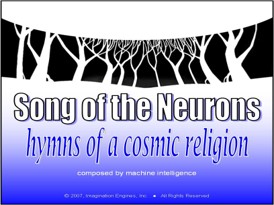 May 13, 2007. IEI Releases the First Totally Machine Generated Musical Album. On this date, Imagination Engines released the album "Song of the Neurons," a collection of 14 musical compositions written by a Creativity Machine, without recourse to the approaches used by computational musicians (i.e., rules and templates. Instead, this neural architecture bootstrapped itself to impressively high levels of musical prowess by simply observing Thaler's facial expressions as it generated candidate melodies.
May 13, 2007. IEI Releases the First Totally Machine Generated Musical Album. On this date, Imagination Engines released the album "Song of the Neurons," a collection of 14 musical compositions written by a Creativity Machine, without recourse to the approaches used by computational musicians (i.e., rules and templates. Instead, this neural architecture bootstrapped itself to impressively high levels of musical prowess by simply observing Thaler's facial expressions as it generated candidate melodies.
December 28, 2007. IEI's STANNO and Creativity Machine Speed Increased 10X. IEI has succeeded in parallelizing and embedding its patented neural network paradigms on graphical processing units (GPU). Now IEI SuperNets have been greatly accelerated on PCs, with most of the processing load taken off the CPU.
June 27, 2008. Providing Michigan Jobs. The platform company, Imagitron, LLC is formed to generate myriad projects in the state of Michigan in an effort to boost the economy there.
September 25, 2008 Michigan Senate Resolution SR 0223. The state's Senate approved a resolution recognizing the achievements of Dr. Stephen Thaler and his Michigan-based company Imagitron for "piercing the veil of technology and determining that Michigan will be home for his legacies." This resolution was sponsored by Senators Valde Garcia, Thomas George, Wayne Kuipers, John Pappageorge, Cameron Brown, Tony Stamas, Jim Barcia, Jason Allen, Roger Kahn, Gerald Van Woerkom, John Gleason, who all clearly understand the immense economic impact of an invention having such fundamental scientific and technical significance.
November 18, 2008. DABUI Patent Issues. Our latest US patent 7,454,388, "Device for the Autonomous Bootstrapping of Useful Information." issued. This patent allows our Creativity Machines to bootstrap themselves to progressively higher levels of creative competence.
February 1, 2009. Advanced Machine Vision with US Air Force. IEI has embarked upon a one year effort with AFRL investigating various applications of its patented neural network paradigms in the area of machine vision.
March 9, 2009. Advanced Machine Vision for the Automotive Sector. IEI has embarked upon a contract with a major, yet heretofore anonymous, Asian automotive company.
March 27, 2009. Japanese Creativity Machine Patent.Japan Grants First Creativity Machine Patent 4282760, "Device for the Autonomous Generation of Useful Information.
 June 2, 2009. The Automation of Invention. The official magazine of the World Future Society, The Futurist, discusses the Creativity Machine Paradigm in the context of automated invention and Robert Plotkin's new book The Genie in the Machine: How Computer-Automated Inventing is Revolutionizing Law and Business."
June 2, 2009. The Automation of Invention. The official magazine of the World Future Society, The Futurist, discusses the Creativity Machine Paradigm in the context of automated invention and Robert Plotkin's new book The Genie in the Machine: How Computer-Automated Inventing is Revolutionizing Law and Business."
June 1, 2011. Thaler briefs DHS Founder, Steve Thaler, briefs Under Secretary of Homeland Security, Science & Technologies Directorate, on the Creativity Machine Paradigm and its implications for what else but homeland security.
July 21, 2013. Building Conscious Machine Intelligence. Thaler presents a talk entitled "How to Build a Conscious Machine," at the World Future Society Conference in Chicago, Ill. Much of the subject matter therein foreshadows IEI's "Sunshine Transit" project to build multi-trillion neuron synthetic brains.
December, 2014. The Rhythm of Consciousness. Thaler publishes "Synaptic Perturbation and Consciousness" in the Internaltional Journal of Machine Consciousness (JMC). Therein he derives an equation relating the tempo of stream of consciousness to the novelty of the thought being produced.
July 2016. Beyond Just the Rhythm of Consciousness. Thaler presents a paper, "Pattern Turnover within Synaptically Perturbed Neural Systems," to the Biologically Inspired Cognitive Architectures conference (BICA 2016) on July 19 in NYC. Therein he discusses his 2014 paper in IJCM, thereafter laying the foundation for IEI's Sunshine Transit project.
July 2016. The Link between Mental Illness and Insanity. Thaler publishes a new article in the journal Medical Hypotheses, entitled "Cycles of Insanity and Creativity in Contemplative Neural Systems." Therein he uses the Creativity Machine paradigm to demonstrate that ideation does not occur instantaneously within the brain, instead being the result of numerous swings between chaotic and tranquil states of the neural system. Even more importantly, the novelty of the creative product generated tends to increase with magnitude of these swings, along with attendant craziness. Essentially, this new model substantiates not only the intuitive observations over the millennia that genius is tainted with madness, but also statistical correlation between psychopathologies and significant creative achievements.
October, 2016. Computers Should Be Named on Patent Applications. Dr. Ryan Abbott feels that computers should be named on patent applications to reflect their inventorship, using the Creativity Machine as "Exhibit A." Holy cow! Can our workstations be held responsible for crimes? For more on this attorney's view on this hot topic, see "I Think, Therefore I Invent."
January 16, 2019. Beyond Just Cognitive Computing! Thaler presents "The Dawn of Conscious Computing" at the Artificial Intelligence and Intelligent Automation Forum (ACT-IAC), Washington, DC.
July 12, 2019. The Disruption That Is DABUS: Beyond AI. Thaler provides a preview of his newest AI patents at Nashvilles's Disruption Lab, with an emphasis upon potential medical applications of the technology.
September 24, 2019. DABUS Becomes a Patent. Thaler is granted US Patent 10,423,875, #DABUS, an implementation of a Creativity Machine on an exceptionally large scale. Otherwise known as "Electro-optical device and method for identifying and inducing topological states formed among interconnecting neural modules", this patent relies upon chains of neural nets to encode ideas, as well as the repercussions of such ideas.
February 19, 2021. Move Over Deep Learning, VTL Is Here!"Thaler publishes a new paper in the Journal of Artificial Intelligence and Consciousness entitled "Vast Topological Learning and Sentient AGI." In it, he describes a totally new neural network paradigm that allows the scaling of artificial neural systems to trillions of neurons, as well as a mechanism to account for the brain's sentient experience.
